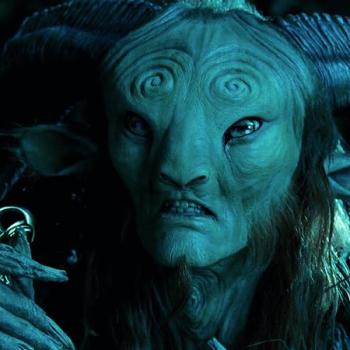
It’s become almost an article of faith that “toxic fans”—those who like to rail online against the recent installments of sagas like Star Wars and Jurassic Park—are mad about casting diversity, “wokeness,” or bad CGI. That’s always felt incomplete to me. There have been bad movie sequels since time immemorial, but those failures are not all alike. Nobody thinks, for instance, that Jaws is retroactively tarnished by its wretched follow-ups. No, I suspect that the sequels that make audiences genuinely angry are the ones that tap into some latent element of the original and “pull it forward” in an unsatisfactory way, forcing uncomfortable questions about the “after the happily-ever-after” to the surface.
And what is this latent element? By and large, I suspect it’s the theme of technological progress, an undercurrent which inevitably unsettles the status quo when it’s allowed to help propel a narrative.
One of the biggest complaints about the Star Wars franchise—all eleven films of it—is its overreliance on the Death Star as an omnipresent threat. Not only does it get blown up in A New Hope and (mostly) replaced in Return of the Jedi, Count Dooku teases it in Attack of the Clones and we see it under construction at the close of Revenge of the Sith. It’s the driving plot threat of Rogue One, gets upgraded to planet-sized scale in The Force Awakens, and gets downsized to a portable version in The Rise of Skywalker.
In one sense, yes, this does reek of creative exhaustion. But viewed from a different angle, it represents an organic storytelling continuity across the saga—a continuity defined by the progress of technology.
Just consider the trajectory. The first Death Star takes painfully long to get into firing position off Alderaan and Yavin IV, and is unable to defend itself directly against assaults. Its successor, by contrast, has a powerful cannon capable of taking down capital ships. Episode VII’s Starkiller Base can strike multiple planets at once. And by Episode IX, planet-killing technology is everywhere.
But if we’ve suspended our disbelief enough to accept A New Hope on its own terms, this is exactly what we should expect to happen. Once Death Star-style technology is released into the world, that’s not a genie that can be crammed back into the bottle. And so, viewer frustration with this storytelling motif is, in a very real sense, frustration with the very logic of human history and experience; paradoxically, in wanting an end to Death Stars, we want the internal plausibility of the Star Wars storytelling universe to collapse.
Something similar can be said about the Jurassic Park film series, which maintains a consistent thematic emphasis on the advance of genetic technology. While the first film was a pleasantly thrilling little fable about human hubris, its sequels draw out the cascading consequences of unrestricted genetic engineering, which must inevitably spill over into other domains (human cloning, as we see in Fallen Kingdom). And what else would we expect from self-interested human beings? The kindly-if-naïve entrepreneur John Hammond is succeeded by grasping nephew Peter Ludlow, just as slick neoliberal Simon Masrani has his legacy plundered by a cabal of dirty scientists and weapons dealers. Almost everything that has followed from the original flick—and that has frustrated fans—is an intelligible development of the first film’s own inner logic.
So too, there’s a parallel undercurrent of storytelling that pervades the series—yes, even and especially the much-hated Jurassic Park III—centered on the nature of Velociraptors. In the first and second films, they are calculating predators—no more, no less. In the third, their capacity for care and restraint becomes evident. By the fourth, they are “antiheroes” of a sort, capable of something very like altruism, and by the fifth, they are contrasted with a grotesque behavioralist parody (the Indoraptor) that responds to stimulus but appears to lack any real interiority.
Again, it’s possible to write this off as merely increased ridiculousness and a lack of creativity. But the theme is too coherent, I think, for that—taken as a whole, it’s a plot thread that deepens the larger critique of genetic engineering by extending it beyond simple terror. The Velociraptor intelligence subplot stresses our lack of understanding of the most proximate reality of all—consciousness—in our obsession with manipulating biomass for our own purposes. Ultimately, the triumph of biotechnology, the Indoraptor, proves in a very real sense to be the most “mechanical” entity of all.
One can certainly fault Jurassic Park III, the Disney Star Wars trilogy, or other similarly situated films—The Matrix Resurrections comes to mind—for their various cinematic deficiencies. But at the end of the day, I suspect that the deep reason they’ve made audiences so angry is that they manage to tap into a widespread sense of discomfort—even a subconscious one—with the pace of technological change, and its ability to unsettle seemingly timeless circumstances. What audiences are longing for, however obscurely, is a kind of “eschatological time” where stories actually conclude in triumph rather than being left to play out their own dark inner logic. And so, strangely enough, it’s not that these sorts of sequels are disliked for being “ridiculous” or “farfetched” (consider the Fast and Furious series). Rather, it’s that they’re hated for being too plausible.
By contrast, Peter Jackson’s beloved Lord of the Rings adaptation deliberately dodges this threatening technological element, in direct defiance of the spirit of its source material. Onscreen, once the larger world of Middle-earth is put back in balance, Frodo and Sam and the other hobbits can return home to a largely unchanged Shire. That’s not the case in the book: the hobbits return to discover that the wizard Saruman’s campaign of industrialization has spread into their homeland, polluting and tainting the once-lush landscape. Before any of the hobbits can settle down in peace, they must confront this threat and drive it out of the realm.
When I first finished reading the book, I recall being left with a bitter aftertaste I couldn’t define. Now, I realize it’s the cloud of inevitability that looms over the novel’s coda: merely expelling the forces of industrial modernity from the Shire won’t finally defeat them. The machines will be back, sooner or later—maybe the next time a famine strikes.
In lieu of that aftertaste, Jackson gives us a vision of “time redeemed,” with the technological menace swept off into the shadows and forgotten. Evasion of this sort makes for a compelling movie. But it also makes for a less honest movie, one that subverts Tolkien’s own concerns and resists the thrust of its own internal logic.
Suffice it to say that, if these sequels teach anything at all, they suggest that we ought to cultivate a healthy skepticism about our ability to foresee the consequences of the innovations we celebrate. Else, the world we build may end up being rather more uncomfortable than we anticipated.












